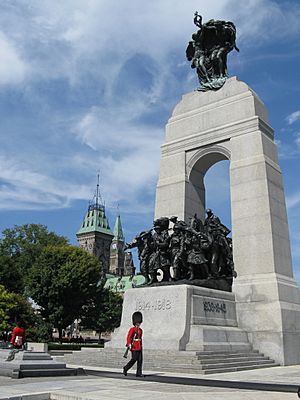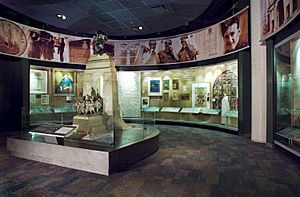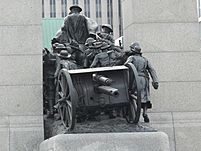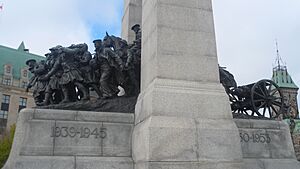National War Memorial (Canada) facts for kids
| The Response (La Réponse) | |

Two Ceremonial Guard sentries at the National War Memorial in Ottawa
|
|
| Coordinates | 45°25′26.53″N 75°41′43.79″W / 45.4240361°N 75.6954972°W |
|---|---|
| Location | Ottawa, Ontario, Canada |
| Designer | Vernon March |
| Type | War memorial |
| Material | Granite, bronze |
| Length | 15.9 metres (52 ft) |
| Width | 8 metres (26 ft) |
| Height | 21.34 metres (70.0 ft) |
| Opening date | 21 May 1939 |
| Dedicated to | Canadian dead of all wars |
The National War Memorial (French: Monument commémoratif de guerre du Canada) is a very important monument in Ottawa, Ontario, Canada. It is also called The Response (French: La Réponse). It has a tall arch made of granite and bronze statues. Vernon March designed it. King George VI first opened it in 1939.
The memorial was first built to remember Canadians who died in the First World War. Later, it was updated to include those who died in the Second World War and the Korean War. In 2014, it was updated again to include Canadians from the Second Boer War and the War in Afghanistan. Now, it honors all Canadians who have died or will die in any conflict. It is one of Canada's most important war memorials. In 2000, the Canadian Tomb of the Unknown Soldier was added in front of the memorial. This tomb represents all Canadians who have given their lives for their country.
Contents
What is the National War Memorial?
The National War Memorial is a central point in Confederation Square in Ottawa. This square is surrounded by important buildings. These include Parliament Hill, the Rideau Canal, and the National Arts Centre. Many other monuments are also nearby. These include the Peace Tower and the Animals in War Memorial.
Why is the National War Memorial Important?
Since 1940, the National War Memorial has been the main place for Canada's Remembrance Day ceremony. This event happens every year on November 11. The Royal Canadian Legion organizes it. Many important people attend this ceremony.
- The Governor General
- Sometimes members of the Canadian Royal Family
- The Prime Minister
- The Silver Cross Mother (a mother who has lost a child in military service)
- Representatives from the Canadian Armed Forces and Royal Canadian Mounted Police
- Diplomats from other countries
- Young people
These groups place wreaths at the memorial. Between 25,000 and 45,000 people attend. The ceremony is shown on TV across Canada.
How the Memorial is Cared For
Before each Remembrance Day, the area around the memorial is carefully prepared. Workers fix stones and clean the bronze statues. They also set up sound systems and TV cameras. Any items left by visitors after the ceremony are given to the Canadian War Museum. Money left is donated to a veterans' health center.
When the King or Queen of Canada visits Ottawa, they always lay a wreath at the memorial. Important visitors from other countries also sometimes do this. For example, US President John F. Kennedy and French President François Hollande have laid wreaths here.
Summer students also work at the memorial. They provide information about its history to visitors.
How the Memorial Looks
The memorial is about 21.34 meters (70 feet) tall. The arch itself is about 3.05 meters (10 feet) wide. It is made from 503 tonnes of rose-grey Canadian granite. It also uses 32 tonnes of bronze. All of this rests on a strong concrete base.
At the very top of the arch are two large statues. They represent peace and freedom. They stand close together to show that these ideas are connected. One figure holds a torch, like the Roman goddess Demeter. The other has wings and a laurel, like the Greek goddess Nike (victory).
Below these figures are 22 bronze statues of Canadian service members. They represent different parts of the military from the First World War.
- In the front, you can see a machine gunner and an infantry soldier.
- Next are a pilot and an air mechanic from the Royal Canadian Air Force.
- A sailor from the Royal Canadian Navy is also shown.
- Two figures on horseback represent the Canadian Cavalry Brigade and a dispatch rider.
- Two infantry riflemen are pushing through the arch.
- Behind them are support staff, including two nurses, a stretcher bearer, and members of the Canadian Military Engineers and Canadian Forestry Corps.
- Other figures include members of the Royal Canadian Army Service Corps, Royal Canadian Corps of Signals, and Royal Regiment of Canadian Artillery.
The figures are shown moving forward, as if answering a call to duty. Each statue is about 2.4 meters (8 feet) tall. This makes them look larger than life. Their faces show pride, determination, and a strong sense of purpose. They wear real Canadian uniforms from that time. The artist, Vernon March, made sure they didn't look like they were from any specific region or background. This shows the unity of Canada.
Vernon March wanted the memorial to show "the people of Canada who went Overseas to the Great War." He wanted it to be a record for future generations. The figures of peace and freedom landing on top represent the blessings of victory and liberty. The people moving through the arch can also mean Canada's "coming of age" as a nation during the First World War.
On the sides of the memorial's base, you can see dates.
- The years 1914–1918 (for the First World War) are above the words Service to Canada/Au service du Canada. These words honor all Canadians who have served in any war.
- The years 1939–1945 (for the Second World War) and 1950–1953 (for the Korean War) are on other sides.
- The years 1899–1902 (for the Second Boer War) and 2001–2014 (for the War in Afghanistan) were added later.
The Canadian Tomb of the Unknown Soldier is right in front of the memorial.
History of the Memorial
How the Idea Started
People started talking about building a memorial for those who died in the First World War even before the war ended. Prime Minister Robert Borden said in 1915 that a "splendid monument" should be built. There was some disagreement about the cost, especially during the Great Depression.
In 1921, Prime Minister William Lyon Mackenzie King's government suggested building a national memorial in Canada. They decided the best place would be in downtown Ottawa. This spot would have the parliament buildings as a backdrop. Mackenzie King said this would make it the most visible spot in the city.
In May 1923, the government asked for money to start the project. There was a lot of discussion in parliament. Some people thought the money could be better spent helping veterans. But Mackenzie King argued that a nation needs art and monuments to remember its history and sacrifices. Parliament finally approved $10,000 to begin.
Choosing the Design and Building It

In 1925, a competition was held to find a design for the memorial. The budget was $100,000. The monument was meant to honor those who served in the First World War. It also had to show Canada's national character. The rules said it should show "the spirit of heroism, the spirit of self-sacrifice." It should also bring "a new hope... for future prosperity under peaceful conditions."
One hundred and twenty-seven designs were sent in. The winner was Vernon March from the United Kingdom. His design showed Canadians responding to the call of war. He wanted to avoid showing war in a glorious way. He wrote that the figures would show "eagerness and enthusiasm" to respond.
Work on the memorial began in 1926. Vernon March's six brothers and his sister helped him. They finished the work after March died in 1930. The design changed a bit over time. The number of figures increased, and so did the cost. This led to more debates in parliament. Some politicians still thought the money should go to veterans.
The bronze sculptures were finished in 1932. They were shown in Hyde Park, London. People noticed that the arch was too narrow for an artillery carriage to pass through. So, the March family made the arch wider and taller. They also added three more figures to the group.
There was a long argument about where to put the monument. Many people didn't like the chosen spot in Connaught Place. But Prime Minister Mackenzie King insisted on it. He worked with architect Jacques Gréber to plan the area.
The bronze statues finally arrived in Ottawa in 1937. The construction of the granite arch and base was completed in October 1938. The total cost had risen to over $1,300,000. The figures of peace and freedom were placed on top of the arch on the same day the Munich Agreement was signed in Germany. Mackenzie King hoped this meant peace would last.
Opening and Changes Over Time

The memorial was officially opened on May 21, 1939. King George VI dedicated it. Queen Elizabeth, the Governor General, and Prime Minister Mackenzie King were there. About 100,000 people attended, including 12,000 veterans. The King spoke about Canada becoming a nation by defending freedom. After the ceremony, the King and Queen walked among the crowd. This was very unusual for a monarch.
Soon after, the Second World War began. This made people think about the memorial's meaning. At first, it was only for the First World War. But as Canadians died in new wars, the memorial became a symbol for all war dead.
Veterans' groups wanted new memorials for the Second World War and Korean War. They felt the existing memorial was only for the First World War. But over time, the National War Memorial in Ottawa became the main place for all Canadians to remember their war dead. This was because of its location and its use for Remembrance Day ceremonies.
In 1980, the Royal Canadian Legion asked to officially rededicate the memorial. They wanted it to include those from the Second World War and Korean War. This was quickly approved. On May 29, 1982, Governor General Edward Schreyer rededicated the monument. The dates 1939–1945 and 1950–1953 were added.
In 2000, the Canadian Tomb of the Unknown Soldier was added in front of the memorial. Governor General Adrienne Clarkson dedicated it on May 28, 2000. This tomb represents all unknown Canadian soldiers.
On November 11, 2014, the memorial was updated again. It now formally recognizes all Canadians who have served, are serving, or will serve. The dates 1899–1902 (for the Boer War) and 2001–2014 (for the War in Afghanistan) were added.
Remembering the Memorial
On May 15, 1939, Canada's Post Office Department released a stamp called National Memorial. It featured the monument. The Royal Canadian Legion also sells pins with the memorial's image.
The original model that Vernon March created for the competition is now at the Canadian War Museum. It is displayed in the museum's Royal Canadian Legion Hall of Honour. This gallery shows how Canada has remembered its conflicts throughout history.
Images for kids
-
Panoramic view of Confederation Square looking north, with the National War Memorial at its centre
-
The sculptures on display in Hyde Park, London
-
Sentries from the Ceremonial Guard at the National War Memorial. The Canadian Tomb of the Unknown Soldier is visible in the foreground.










